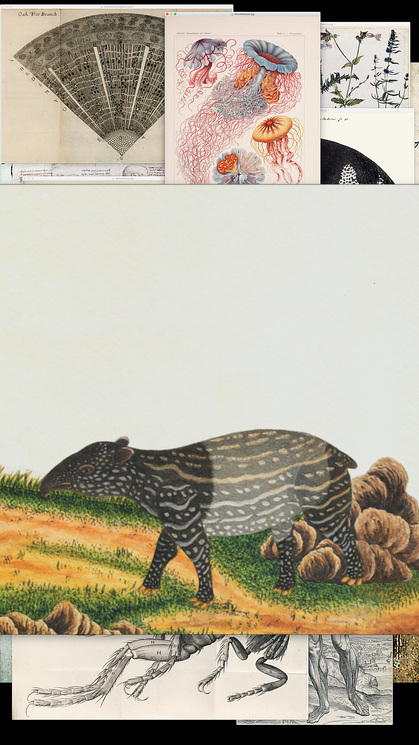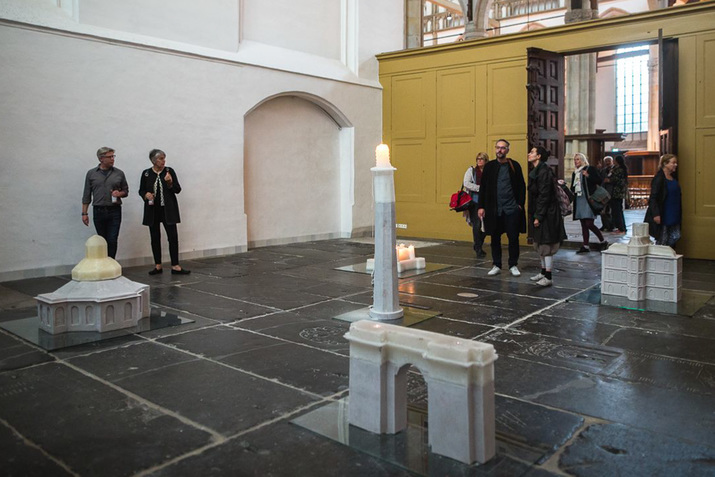
R
E
V N
E
X
T
Installation view of ISWANTO HARTONO’s Monuments, 2017, wax, FRP, dimensions variable, at Europalia Indonesia, Oude Kerk, Amsterdam, 2017. Courtesy Oude Kerk.
Hsu Chia-Wei’s four-channel video installation Black and White – Malayan Tapir (2018) lays out a constellation of histories and legends revolving around the titular mammal through images of taxidermic creatures, scientific illustrations, as well as watercolors of plants and animals from The William Farquhar Collection of Natural History Drawings. In the last minute-and-a-half of the encyclopedic narrative, one sees two statues of Sir Stamford Raffles—one black, the other white—that comically shape-shift and fuse to become a Malayan tapir in its enclosure. The work examines an episode regarding the identification of the fauna, involving Raffles, who is often hailed as “the founder of modern Singapore,” and Farquhar, the first British resident and commandant of colonial Singapore. Aside from butting heads over the country’s administration, the two part-time naturalists competed to claim the “discovery” of the species and for the right to name it. What they both neglected, however, was the long-established Indigenous knowledge about the Malayan tapir. Confronting the black/white binary evoked by the colors of the statues and the animal, the installation challenges the assumption that colonial-era scientific developments were bias-free, and that legacies such as natural history collections are objective. Hsu instead points to the complexity and continued mutability of colonial narratives.
The two statues featured in Hsu’s work currently stand in the Civic District of Singapore, a stone’s throw away from each other. The black bronze rendering of Raffles is in front of the Victoria Memorial Hall and was unveiled in 1887 to commemorate Queen Victoria’s Jubilee Day. Recast from this black bronze sculpture, the gleaming, white polymarble version was erected in 1972, shortly after Singapore became an independent republic—a symbolic gesture conveying that the country is still safe for Western capital—and is prominently located at Raffles’ Landing Site. It is exceptional that these two statues remain installed. For many other Southeast Asian nations, the turbulent period of Japanese imperialism saw the toppling and alteration of monuments with references to Western colonial powers. Anti-colonial sentiments continued through the 1950s and ’60s when the J. B. van Heutsz Monument in Jakarta was removed, for example. While there were plans to melt the black bronze statue of Raffles in 1942 amid the Japanese occupation of Singapore, today, the sculptures are still intact and are celebrated as national icons. This reflects how the influence of colonialism extends to the ethos and values of present-day, post-independence Singapore, which privileges the colonial encounter as pivotal to its modern intellectual and economic growth based on free trade and global capital. Meanwhile, the city-state neglects its migrant workers and other minorities, reiterating a colonial view, as professor Brenda Yeoh pointed out at a 2019 conference marking the bicentennial of Raffles’ arrival.
In referencing the pair of monuments, Black and White – Malayan Tapir gestures to how representations from the past continue to condition the present. Discussions on decolonization have recently gained urgency as controversies about and mass protests against colonial monuments have surfaced across the world. In this context, curator and historian Paul Farber and artist Ken Lum noted collectively in an Artforum interview, “Monuments as traditionally conceptualized are thought of as the endpoint of a historical event or period.” But, the two continue, “What if we thought of them as a continuation, as the bridge between what happened and how time falls forward? Or as discontinuous eruptions? Time is not linear.” In Hsu’s work, the amalgamation of the two statues into a Malayan tapir prompts one to reimagine monuments and re-examine colonial histories in the contemporary moment as shifting elements endowed with variable, malleable identities that blur the contours between forgetting and remembering.
Likewise, Iswanto Hartono explores the tensions between remembering and forgetting in his installation Monuments (2017) by forming facsimiles of Dutch colonial statues and buildings in Indonesia out of wax. The structures that he replicates include Fort Belgica in Banda Aceh; the Vlakkenhoek Lighthouse in Sumatera; and Jakarta’s Wayang Museum, Amsterdam Gate, Mohr Observatorium, and statue of Jan Pieterszoon Coen—an officer of the Dutch East India Company (VOC) and the governor general who founded the Dutch colonial capital Batavia. Hartono’s wax sculptures were set alight over eight weeks. As the pieces melted and morphed, they reminded viewers that historical monuments are not static or permanent—they are transient and embody shifting and sometimes contradictory meanings in different cultural contexts.
In reality, three of the monuments that Hartono selected have disappeared from the landscapes of Indonesia. These include the statue of Coen, which was torn down in 1943 during the Japanese Occupation of Indonesia. The Amsterdam Gate was removed in 1950, while the Mohr Observatorium was damaged by an earthquake in 1780 and was later demolished in 1812. But “does it mean they are forgotten once they are no longer physically there?” Hartono asks. While destroying symbolic objects can signal a break with and rejection of the past, colonial legacies can still endure. Monuments was installed at Amsterdam’s Oude Kerk (old church) museum, the city’s longest surviving building. The construction of the historical locale was funded by the VOC, and it is the burial site of many prominent VOC seafarers. In the context of the place of worship, the work’s media brought to mind the votive candles that people light in remembrance of those who have passed. In line with these paradoxes, the artist surmises, “in order to forget, we must remember first.”
Memory and meaning also converge in Motoyuki Shitamichi’s torii series (2006–12). The photographs trace the current purposes and conditions of torii gates erected across the Asia-Pacific during Japanese colonial rule from the Meiji period (1868–1912) to the end of World War II in 1945. While torii are typically built at the entrances of Shinto shrines and commonly denote the boundaries of the sacred spaces, Shitamichi evidences that some of these structures have changed in significance and character. As objects, they have been altered to suit local cultures and lifestyles or have been subsumed by the landscape. For example, one image shows a torii laid on its side and used as a park bench in Taichung City, while in South Korea, many have been destroyed. As memories dissipate and relics disintegrate, historical realities are obscured and get buried in daily life. While Shitamichi’s images do not necessarily display Japan’s history of conquest, they respond to remnant sites of trauma and show how imperial histories remain physically present, despite the lack of formal acknowledgment of the narratives that these objects signify. Further, the adaptations of these torii are very much reminiscent of how, in the Asia-Pacific region, World War II events are memorialized and narrated depending on the historical view, political situation, and culture of the different countries.
In light of recent global demonstrations calling for the removal of statues that celebrate or memorialize colonial histories, discussions surrounding the legitimacy and pervasiveness of such monuments continue to gain momentum. Situated in different contexts, the works of Hsu, Hartono, and Shitamichi offer rich and alternative sources of engagement with monuments of various forms. In the artists’ projects, commemorative markers are awakened from their static and lifeless states and become images and symbols that animate the possibilities to disrupt, evaluate, and reimagine their embodied meanings. Converging official and alternative views of the past, the works bring to the fore the complexity of the forces that shape historical narratives, memory, and colonial legacies.
Lynda Tay is the second-place winner of ArtAsiaPacific’s 2020 Young Writers Contest. She is an assistant programmer at Singapore’s performing arts center Esplanade – Theatres on the Bay.
To read more of ArtAsiaPacific’s articles, visit our Digital Library.

















